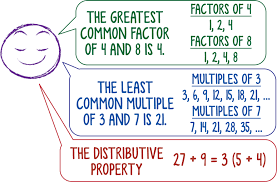The prime factors of numbers can be used to calculate the LCM of two or more numbers. LCM stands for the lowest or the least common multiple. Thus, LCM is the smallest number that can be divisible by a given set of numbers. It implies that the LCM must be a multiple of all the numbers. In other words, when we are given two or more numbers, then the LCM is the smallest value that can appear as a multiple and can be divided by any of the given numbers. Suppose we have two numbers, p and q, then the least common multiple is denoted LCM (p, q). LCM is used when we have to perform arithmetic operations on unlike fractions such as addition, subtraction, or comparison to equalize the denominators of all the given quantities.
In this article, we will learn more about how prime factors can be used to calculate the LCM of numbers.
Prime Factorization
The first method that is introduced to kids when they are learning how to find the LCM is the listing method. Here, we first list out some of the multiples of the given numbers. We then take the common multiples and find the one with the lowest value. This is the LCM of those numbers. However, the problem that crops up with such a method is that when we deal with numbers having a large number of digits, finding the first common multiple amongst all might be a tedious and time-consuming task. Thus, in such a case, we have to resort to another technique known as the prime factorization method. In this method, the first step is to find all the prime factors of a number. We need to express the numbers as a product of their respective primes. We then need to multiply the prime factors of all the given numbers ensuring that a common factor is multiplied only once. This provides us with the LCM. Let us take a look at an example to give us a better understanding of this concept.
Find the LCM of 15, 20, and 25 using the prime factorization method.
Step 1: Prime factorize all the numbers
- Prime Factors of 15 = 3 * 5
- Prime Factors of 20 = 2 * 2 * 5
- Prime Factors of 25 = 5 * 5
Step 2: List down the factors ensuring that common factors are represented only once
- Factors = 2 * 2 * 3 * 5
Step 3: Calculate the LCM
- LCM (15, 20, 25) = 2 * 2 * 3 * 5 = 300
A note to remember is that irrespective of the method used, the LCM of the given numbers will always remain unchanged.
One of the best ways to learn about any topic is by approaching a reliable institution that provides quality education to students, such as Cuemath. At Cuemath, the certified tutors use several resources such as worksheets, puzzles, math games, etc., that are driven towards maintaining a child’s interest in the topic and developing a robust mathematical foundation. If, while solving a problem, kids have doubts, the teacher gives cues to him so that he can come to a conclusion himself rather than directly giving him the answer. This works to develop his reasoning and logical skills. Overall they provide a holistic learning environment to a child.
Conclusion
LCM is used in many daily life applications, and hence, kids must learn about the topic in depth. Hopefully, this article gives you an insight into how to solve such problems, and I wish you all the best in your learning journey.
